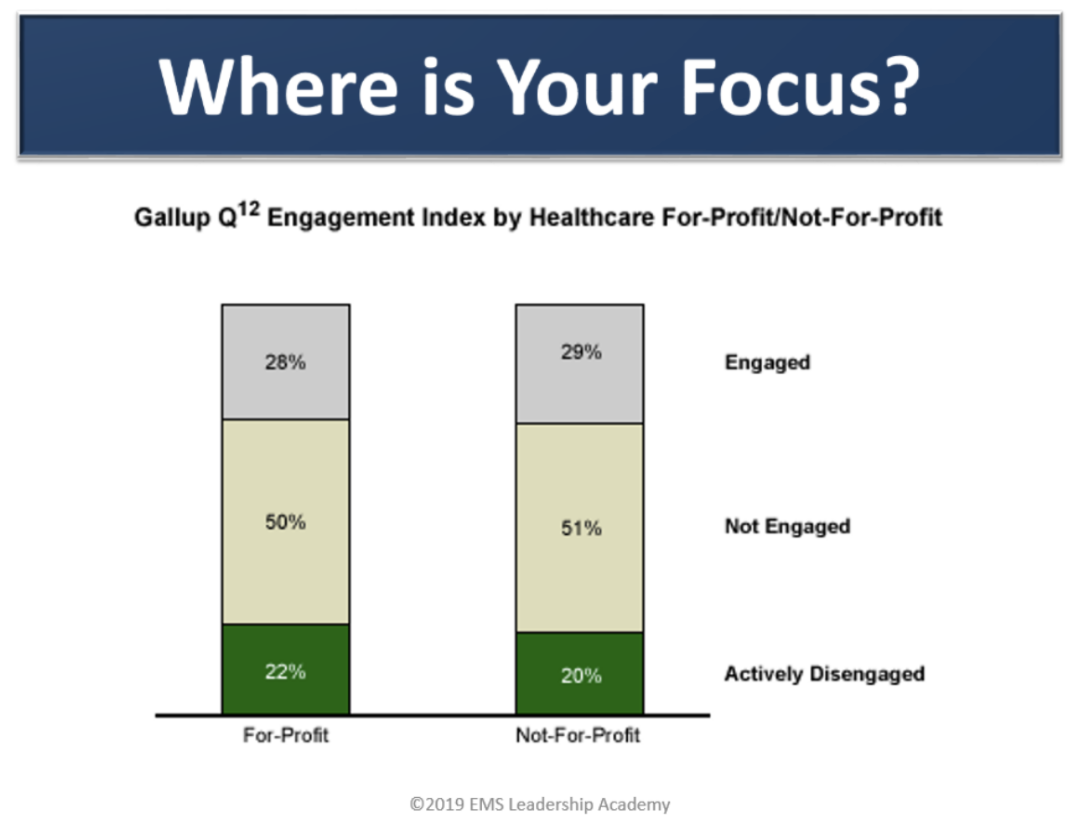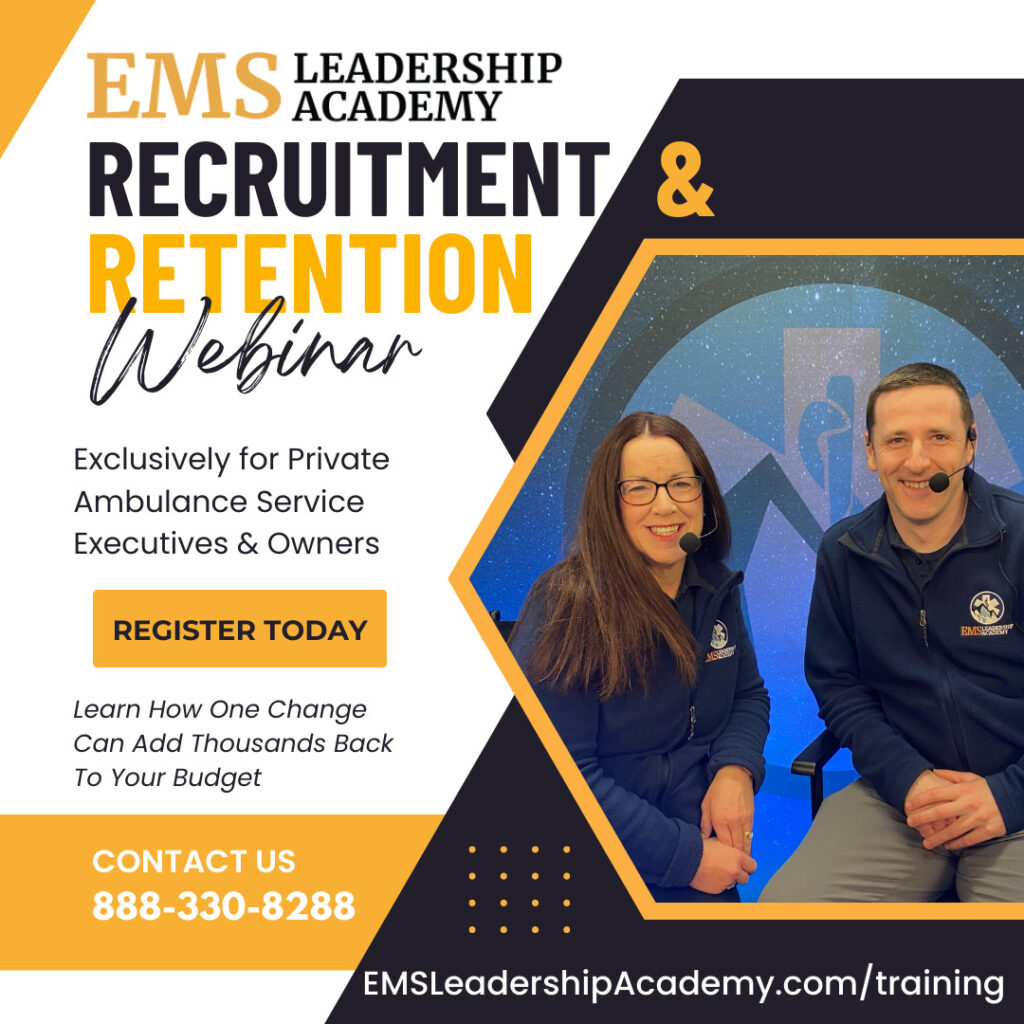- Having less drama, improving communication, and having more cooperation are the results of a culture which is either there by default or by design.
- What (or who) are you focusing on? The 20% who are highly engaged or the 10- 20% who are actively disengaged (drama, poor listeners, uncooperative)

- Shift to a coaching mindset to bring out the best in people vs. correct and tell people what not to do. Model the behavior you want to see and perhaps set up mentors and training opportunities for folks who are in the middle 60-70%
- You’re always training people on how to communicate with you.
What can you do?
Creating a High Performance Team: What are you focusing on article and Keeping the Best
Welcome to today's EMS leadership, Q & A I'm Lisa Giruzzi, I'm here with Robbie MacCue and we are the co-founders of EMS leadership Academy. And if you're unfamiliar, we help EMS leaders bring out the best in themselves. And others Today's question is a very hot topic. It is. How do we have less drama, improve communication and have more cooperation?
It sounds like a very hefty question, but in our experience, we have found that those things, drama community, you know, improved communication and work cooperation are really the Results of the kind of culture that your organization has. It's very easy to blame or look at individuals to see well that one's gossiping or that one's so dramatic, or, you know,
that one doesn't cooperate. Like we look at individuals, but what if those are the results of the organizational culture that is at play and that's producing that. So a lot of times people don't understand what culture is and you know, what do you mean? And it feels like it's too big, but it's really usually by default that the culture exists. It's just been sort of developed over time,
not intentionally designed, and you can actually start to design a culture through changing practices, changing how you communicate and designing it intentionally for the kind of results you want. So you could actually design it to be a cooperative, highly communicative peak performing organization. And a lot of that has to do with what you're paying attention to. Absolutely. Lisa, not only what,
but, but who are you focusing on in your organization? So I think we've got a great graphic here that, that we'd love to reference in the talking about the engagement of people in your organization. So if the question is, how do we have less drama? Well, where, where does the drama generally come from? Maybe it comes from the actively disengaged folks in your organization.
The folks that we've said so many times here, you can give them a desk made out of gold and they would complain how heavy it is. Gallup does this research, mounting and engagement, and really finds that most organizations have around the bottom 20%, the actively disengaged folks are just that. And, but where do we focus our time? It's usually our focus on the squeaky wheel,
on the people bringing up the, the complaints and the issues. And you're, you've got these other part of the organization, the top 25 to 30% of the highly engaged folks. Those are your high performers. They're not causing any problems, right? They're, they're, they're great at what they do, but we tend not to focus on that because we're so focused on the problems that pop up.
And then we have the, in the middle of those 50, 50 to 60%, maybe sometimes that could get pulled in either direction. And that's where we'd invite you to think about what, where are we focusing our energy on and how much, because we're not saying ignore the people at the bottom. People that have complaints have valid concerns. It just doesn't mean we have to focus all of our attention on them,
Right? And if you focus on the top percentage, they're the high performers, the engaged people versus, and versus the low, less engaged or actively disengaged. And you focus on the middle group there and you shift to a coaching mindset. You ask yourself the question, how can I enhance their capacity? How can I help them to develop themselves? You know,
what are, what are the opportunities for those folks to get engaged, to do more, to be more, to have more responsibility. And then you model the behavior that you want to see. And you invite people in that top 20% and the middle percentage to, to participate with you on things. And you're modeling that behavior. And you do this as an M you know,
as an invitation and you invite the high performers to mentor people, and it really creates this culture of excellence. And the folks, again, you don't ignore the complaints you look to see how are these opportunities to grow and develop people. It shifts the mindset, not only for yourself, but if everybody in your organization and then that, you know, all the drama and the poor communication and the lack of cooperation disappears because you're focusing on and developing people in moving towards what you want instead of trying to stamp out what you don't want.
And Lisa, we often showed a quote in the absence of a great vision, pettiness prevails. So I think that's a whole nother topic we could talk about. And we've talked about in other videos is without a vision for the future, you know, pettiness that people have to look forward to where you get your high performers and the folks in the middle,
like rowing in the same direction towards that creates excitement. And I think it's like the antidote to the drama is, is getting people excited about the future and what's possible. Absolutely. And living consistent with it. So, you know, we've all experienced the vision on, you know, a piece of paper or a plaque on the wall, but if it's not a living dynamic thing,
then it actually people will be like, Oh, bull. You know, we're not like that. Let me show you the ways we're not like that. But if it's a, it's something that you use in your organization to develop strategies and structures that are consistent with that, then you're going to have a whole different relationship to it. And people start to feel like they're part of something bigger and better,
and they want to be the best they can be. And as you always say, structure creates Results, right? And if those structures are in line with that great vision of the future, you're going to, the Results are gonna follow. One thing I appreciate about what you say too is you're always training people on how to communicate with you. And I think that's such an important message for leaders.
If you get frustrated, when people come to you with a question, guess what? They're probably not going to come to you with a question anymore. They're probably going to avoid the heck out of you, right. Or come to you when it's too late, you know, there, you know, like when it's an emergency. So yeah. We're always training people how to treat us,
how to communicate with us. So it's really important to start with yourself. Absolutely. So we have a great resource for you. It's an article on our blog. You can just go to our website, Demas leadership academy.com and either click on the blog tab and look for it, or type this address and creating a high performance team. It's a very insightful article that leads you through a process.
It leads you to actually a co Lisa mentioned shifting to a coaching mindset. There's a PDF there with six key points to create a coaching mindset. But I, I really love what we've put into that, to that article. Yeah, me too. Well, thank you everyone for joining us for this session of the EMS leadership Academy, Q and a.
If you have a question to submit, please send it to support@emsleadershipacademy.com or you can leave us a voicemail at the number on our screen. Thank you for joining us.



